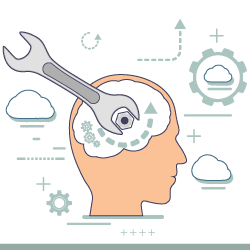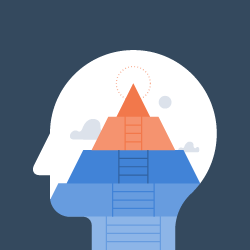6 Steps to Building a Productive Mind!

Dr. Salah Saleh Mammar
Creativity
13
Hurson defined productive thinking as a type of thinking that combines creative and critical thinking skills, and employs them to produce new ideas. Through this definition, he came up with his famous PTM (Productive Thinking Model), which is a set of six steps to build productive thinking.
The first step:
Revolution of feeling the problem, what is going on around me? In this step, a framework is put in place for the problem or opportunities that can be addressed, and different ways of solving or seizing them are explored. To achieve this step, there are a number of questions that must be answered, which are:
- What is the problem? A long list of perceived problems is identified and generated to determine the problem to be addressed.
- What is the impact of this problem? This issue is investigated in depth and how it affects the world is determined.
- What information? At this stage, a detailed and accurate description of all aspects of the problem is made.
- Who is involved in the problem? All those involved in this problem are identified.
- What is the vision? It identifies what the situation would be like if this problem were solved in a different way.
The second step:
What is the required success? Setting the criteria for success in this step is done by defining a vision for the future through solving the problem. At this stage, active imagination is used and things are explored after solving the problem, by answering the following questions:
- Solution: What do you want to do?
- Constraints: What constraints prevent the solution from being implemented?
- Investment: What materials can you invest in this solution?
- Values: What values should be taken into account in this solution?
- Consequences: What are the expected outcomes of this solution?
The third step:
What is the question? Identify the real problem. In this step, the problem is formulated into an answerable question. This is accomplished by discussing ideas and extracting as many questions as possible, then collecting these questions and choosing the question or questions that seem most realistic.
The fourth step:
What are the possible solutions? By using brainstorming, the largest number of ideas are generated, as in this step a long list of possible solutions to the problem is created, and the best solution from these solutions or several solutions combined is chosen for further development.
Step five:
What is the best solution? Through a set of questions, the chosen solution can be developed:
- Identify the positives: What is good about the idea?
- Identify the negatives: What is bad about the idea or solution?
- Determine the additions: What is the added value of the idea over other ideas and solutions?
- Identify enhancements: How can this solution be improved?
- Identifying interferences: How can we correct the bad things in the solution?
Step 6:
How to organize resources? Create a business plan, and in this final step the selected solutions are translated into a business plan that includes:
- Preparing lists of proposed solutions.
- Determine a specific timetable for each stage.
- Identify lists of people who will participate in implementing the proposed solution.
- Identify points and issues that need further work to develop.
Did you benefit from the information provided on this page?
visitors liked this page



